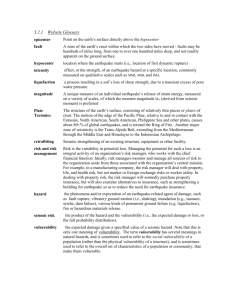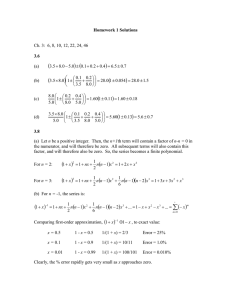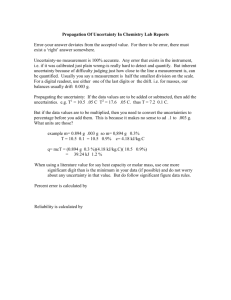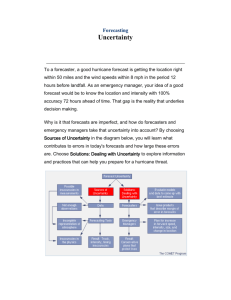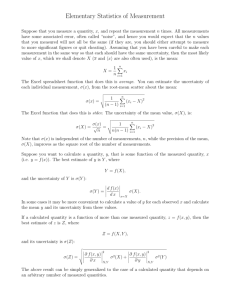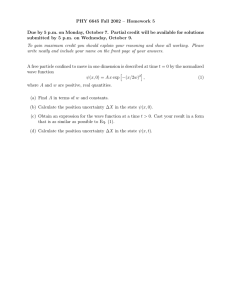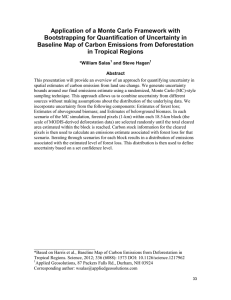Analytical Evaluation of Uncertainty Propagation in Seismic Vulnerability
advertisement
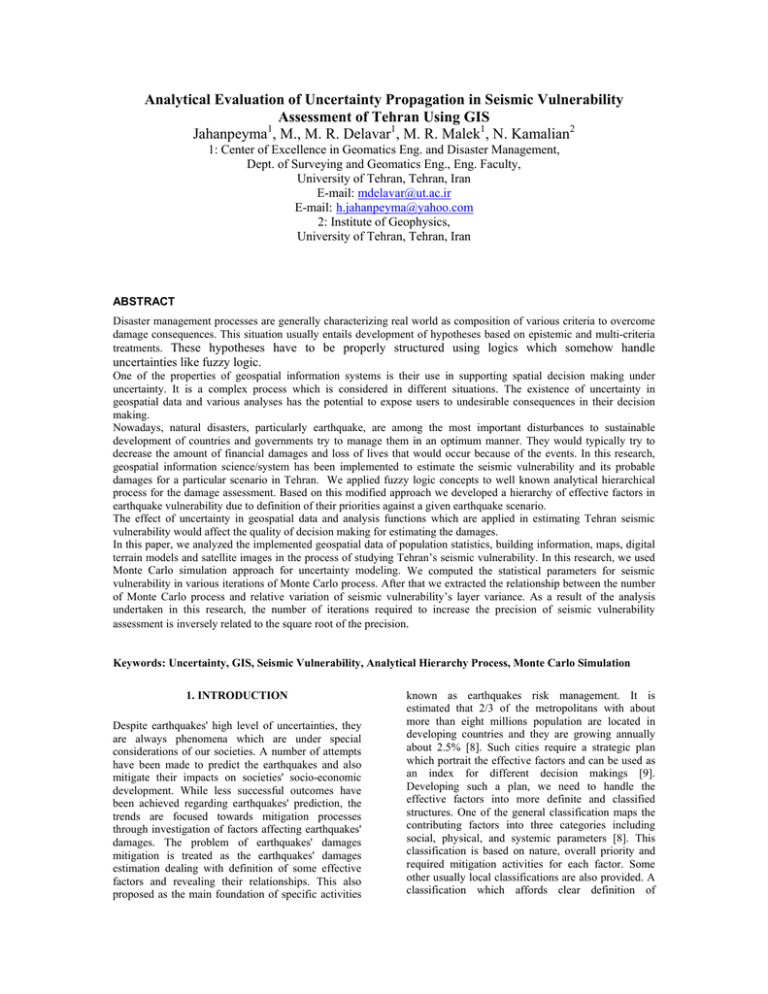
Analytical Evaluation of Uncertainty Propagation in Seismic Vulnerability Assessment of Tehran Using GIS Jahanpeyma1, M., M. R. Delavar1, M. R. Malek1, N. Kamalian2 1: Center of Excellence in Geomatics Eng. and Disaster Management, Dept. of Surveying and Geomatics Eng., Eng. Faculty, University of Tehran, Tehran, Iran E-mail: mdelavar@ut.ac.ir E-mail: h.jahanpeyma@yahoo.com 2: Institute of Geophysics, University of Tehran, Tehran, Iran ABSTRACT Disaster management processes are generally characterizing real world as composition of various criteria to overcome damage consequences. This situation usually entails development of hypotheses based on epistemic and multi-criteria treatments. These hypotheses have to be properly structured using logics which somehow handle uncertainties like fuzzy logic. One of the properties of geospatial information systems is their use in supporting spatial decision making under uncertainty. It is a complex process which is considered in different situations. The existence of uncertainty in geospatial data and various analyses has the potential to expose users to undesirable consequences in their decision making. Nowadays, natural disasters, particularly earthquake, are among the most important disturbances to sustainable development of countries and governments try to manage them in an optimum manner. They would typically try to decrease the amount of financial damages and loss of lives that would occur because of the events. In this research, geospatial information science/system has been implemented to estimate the seismic vulnerability and its probable damages for a particular scenario in Tehran. We applied fuzzy logic concepts to well known analytical hierarchical process for the damage assessment. Based on this modified approach we developed a hierarchy of effective factors in earthquake vulnerability due to definition of their priorities against a given earthquake scenario. The effect of uncertainty in geospatial data and analysis functions which are applied in estimating Tehran seismic vulnerability would affect the quality of decision making for estimating the damages. In this paper, we analyzed the implemented geospatial data of population statistics, building information, maps, digital terrain models and satellite images in the process of studying Tehran’s seismic vulnerability. In this research, we used Monte Carlo simulation approach for uncertainty modeling. We computed the statistical parameters for seismic vulnerability in various iterations of Monte Carlo process. After that we extracted the relationship between the number of Monte Carlo process and relative variation of seismic vulnerability’s layer variance. As a result of the analysis undertaken in this research, the number of iterations required to increase the precision of seismic vulnerability assessment is inversely related to the square root of the precision. Keywords: Uncertainty, GIS, Seismic Vulnerability, Analytical Hierarchy Process, Monte Carlo Simulation 1. INTRODUCTION Despite earthquakes' high level of uncertainties, they are always phenomena which are under special considerations of our societies. A number of attempts have been made to predict the earthquakes and also mitigate their impacts on societies' socio-economic development. While less successful outcomes have been achieved regarding earthquakes' prediction, the trends are focused towards mitigation processes through investigation of factors affecting earthquakes' damages. The problem of earthquakes' damages mitigation is treated as the earthquakes' damages estimation dealing with definition of some effective factors and revealing their relationships. This also proposed as the main foundation of specific activities known as earthquakes risk management. It is estimated that 2/3 of the metropolitans with about more than eight millions population are located in developing countries and they are growing annually about 2.5% [8]. Such cities require a strategic plan which portrait the effective factors and can be used as an index for different decision makings [9]. Developing such a plan, we need to handle the effective factors into more definite and classified structures. One of the general classification maps the contributing factors into three categories including social, physical, and systemic parameters [8]. This classification is based on nature, overall priority and required mitigation activities for each factor. Some other usually local classifications are also provided. A classification which affords clear definition of contributing factors and their relationships would create the basis of the mitigation strategic plan. Among all contributing factors, the social factors usually represent the strongest inter- and intrarelationships [8]. For example, social factors like human fatality and injury play an important role in mitigation strategic plans. The utility of geospatial information system (GIS) as a decision support system/science depends on the development and dissemination of formal models of error for GIS operations. The goal of users should at minimum be provided with a means of assessing the accuracy of the information upon which their decisions are based. Although error models have been developed for certain GIS operations, these models have not been widely adopted in practice. One impediment to their more widespread adoption is that no single error model is applicable in all instances [1]. This paper outlines the assessment of uncertainty propagation in seismic vulnerability in Tehran. Section 2 elaborates uncertainty concept from GIS point of view. Section 3 describes methods of uncertainty modeling. Section 4 discusses Monte Carlo simulation. Section 5 describes the methodology implemented. Section 6 indicates the implementation process and Section 7 concludes the paper. 2. UNCERTAINTY 2.1 The Theory of Error Propagation in GIS The error propagation problem can be formulated mathematically as follows. Let X(.) be the output of GIS operation g(.) on the n input attributes X (.) = g ( A1 (.), A2 (.),..., An (.)) Ai (.) . (1) The operation g(.) may be one of various types, such as a standard filter operation to compute gradient from a gridded digital terrain model (DTM). The objective of the error propagation analysis is to determine the error in the output X(.), given the operation g(.) and errors in the input attributes, Ai (.) . The output map, X(.), is also a random field, with mean, μ(.), and variance, τ (.) . From an error propagation perspective, the main interest is in uncertainty of X(.) , 2 as contained in its variance, τ 2 (.) [10]. 2.2 Uncertainty and risk management Uncertainty, in contrast to error, assumes no prior knowledge of data accuracy. The importance of uncertainty in natural hazard risk management has been recently received much attention [6]. However, it is indeed relatively rare for operational risk-focused GIS applications to consider data or model accuracy and to communicate these inherent uncertainties in the final risk assessments. Simulation techniques such as GIS-based modeling allow natural hazard risk managers to identify the cost-effectiveness of error reduction strategies, including improving database resolution, or performing more detailed ground truthing [6]. Uncertainty analysis also allows risk managers to answer questions about the error bounds of hazard models and to guide future GIS data acquisition. The problem is not so much the existence of uncertainty in GIS data as the traditional response has been to ignore it, on the grounds that methods to handle it do not exist [5]. Goodchild et al. note that, with the inevitable existence of uncertainty in spatial data, there are three responses to dealing with it: 1. To omit all reference to it; 2. To attach some forms of description to the output, or 3. To show samples from the range of maps or outputs possible [7]. The first option is unacceptable and the second may not adequately communicate to risk managers the complex nature of uncertainty in the data and model. Examining the third option is preferable because it would appear to have the greatest potential benefit in both communicating uncertainty and at the same time educating the user community to the significance of the issue. Methods for implementing the latter are described as sensitivity analyses. Sensitivity analysis is the study of the effects of imposed perturbations (variations) on the inputs of a geospatial analysis on the outputs of the analysis. Sensitivity analysis is applicable when no prior knowledge of the truth exists or when analytical error propagation models are not applicable. 3. METHODS OF UNCERTAINTY MODELING An error model refers to a stochastic process capable of simulating the range of possibilities known to exist for spatial data. These possibilities may exist because measuring instruments are known to be of limited accuracy, or because vital information, such as datum or map projection is missing [11]. The methods by which geospatial data uncertainty can be modeled may be categorized into four classes: analytical, simulated, experimental and uncertainty descriptors. The basic geometric components in 2D object-based GIS are points, lines and polygons. They are considered as different objects since their spatial properties and uncertainty behavior is different. Consequently, the uncertainty models that describe the behavior of objects should be different [12]. The analytical method is just an approximation technique. The simulation method requires several interactive operations and hence, the method may not be efficient in practice. Empirical method is based on comparing the object with its true value, making it time and cost consuming. Error descriptors cannot simulate the possible locations of the spatial objects, therefore, they lack the conditions of being statistical error models. The selection of the best method depends on the application, time and cost. 4. MONTE CARLO SIMULATION METHOD The above formulation relies on accurate prediction of structural response by the excitation intensity measure. This may not be true for all structural systems under all possible situations. Any scalar intensity measure would fall short in predicting accurately the detailed structural response behavior. An entirely different approach to the evaluation of the probabilistic structural demand is the Monte-Carlo (MC) method [4]. In principle the problem of uncertainty transmission in GIS operations can be handled by using covariance propagation [13]. The lack of single continuous differentiable function renders the use of explicit equations for error propagation. Instead, it is simpler and more general to use a universal solution based on Monte Carlo simulation approach. The idea of the method is to compute the result of Eq. (1) repeatedly, with input values Ai (.) that are randomly sampled from their joint distribution. The model results from a random sample with the distribution FX (.) of X, so that parameters of FX (.) including the mean, μ , and the variance, τ 2 , can be estimated from the sample. Properties of these estimators are well known from classical sampling theory. The method thus consists of the following steps: 1. Decide what levels and types of error characterize each data set as input to a GIS. 2. Replace the observed data by a set of n random variables drawn from appropriate probability distributions assumed to represent the uncertainty in the data inputs. 3. Apply a sequence of GIS operations to the step (2). 4. For this set of realizations, Li , store the results, X i . 5. Compute summary statistics. 5. METHODOLOGY The seismic vulnerability assessment process is implemented in Tehran, the Capital of Iran. Iran has experienced many earthquakes which some of them created sever fatalities like the earthquake happened in city of Bam in 2003. Tehran is also located in a highly earthquake prone area bounded by three major faults. While, no significant earthquake happened in Tehran for a long time, seismologists predict that huge earthquakes are highly possible in this city. Tehran is known as one of the most vulnerable metropolitans in the Middle East region and north of Africa. While this city seriously sprawled horizontally during the last 50 years, it is now rising out. It hosts more than 7 millions population and also absorbs a great number of migrants as about 93 percents of annual 1 percent population growth in Tehran is due to migration. Despite a great deal of research carried out to show the danger of earthquake in Tehran during the last 30 years and plans which are developed for earthquakes' damages mitigation, lack of a comprehensive plan for urban management caused failure of these activities. Applying more comprehensive researches is required bridging this gap. The hypothesis and methodology illustrated in the previous sections are used here for this purpose. The methodology is defined for our case study as follow: 1. Simplification of the problem is carried out by focusing on earthquake fatalities. The social risk factors fatalities and injuries are selected as basic factors. Debris is also selected as the related physical factor. 2. Considering the selected factors, our research focuses especially on people and buildings. Defining the expected earthquake scenarios we take into account the classification of both the vulnerability of a structure like the materials, method of construction and the degree of damage. This classification would be the simplified version of the European macro seismic scale for earthquake intensity which is provided by European Seismological Commission [14]. The highest level of the classification provided is obtained which consists of three levels: a. light to moderate earthquake b. moderate to severe earthquake and c. severe to destructive earthquake. Each of these levels includes four detailed levels 3. The effective factors selected under the structures defined in the last two steps would be: a. building floors (1-3, 4-15, and more than 15) b. Building's structure type (weakly built or poorly constructed, sturdy or masonry, well built or not reinforced, well built and reinforced) c. Building's age (before 1966, 1966-1975, and 19762005) d. Resident population. In this paper, we selected Monte Carlo Simulation method to utilize the high efficiency of the simulation approach for uncertainty propagation modeling in overlay analysis. Applying Monte Carlo Simulation approach with changing layers and overlaying them, overlaid layer which have the ability of statistical analysis has been achieved (Figure 1). Building and population layers Determination of the number of repetition stages Determination of the uncertainty of input layers The required spatial data are three categories including earthquake risk zoning, building construction condition and population zoning. The method has been adapted uncertainty concept through fuzzy set theory injection [2]. Weak 1<floor<3 Age<1965 3<floor<15 1965<Age <1975 15<floor 1975<Age Unreinforced Disturb the input layer with respect to determined uncertainty Overlaying the input layers and producing vulnerability map Fine Excellent Construction Reserving the vulnerability layer Numbers of floor Age ith Population Building i<N Calculation of mean and standard deviation of the stored layers Figure 1: The implementation of Monte Carlo method in determination of uncertainty in seismic vulnerability map 5.1 The methodology of producing the seismic vulnerability map for Tehran The implemented approach in this research is a multi criteria decision making process using geospatial information system abilities. Seismic vulnerability Figure 2: The process of seismic vulnerability assessment According to Figures 1 and 2, input data layers are converted to data dataset “X” (seismic vulnerability layer). Then, the uncertainty of X data set considering the uncertainties in each data layer has been calculated. If we show the output of X in each repetitions of the changed data with X=[x1, x2, …, xi, …, xn] , the mean of samples (mx) and its variance is calculated: mx = S x2 = where 1 x ∑ ( xi − m x ) x − 1 i =1 mx and S x2 7. CONCLUSION 1 x ∑ xi , x i =1 2 are the estimated mean and variance for the output layer. 6. IMPLEMENTATION In this paper, we have repeated the process with changing the input layers in 10, 20, 50, 100, 150 and 200 times. The achieved results are indicated in Table 1. Table 1: The variance of samples versus the repetition times 2 2 2 N Min. s x Max. s x Mean s x 200 0 0.566250 0.0001271 150 0 0.585125 0.0001314 100 0 0.629167 0.0001410 50 0 0.915522 0.00020 20 0 1.239020 0.000267 10 0 1.770030 0.000382 Based on the results shown in Table 1, we can display the variation diagram of the variances of the output layers with respect to repetition times (Figure 3). According to the results of the simulation, considering the spatial uncertainty in overlay analysis, increasing the number of repetition will improve the variance of vulnerability assessment. However, the effect of this element in conventional geospatial information systems has not been noticed, therefore, propagation and intensification of it may cause some drawbacks and disadvantages in the operation of the systems. So it seems essential that strategic planners and policy makers should take the spatial uncertainty parameters into account to support decision making effectively. With respect to the different kinds of uncertainties, there are various theories to manage and overcome these parameters. Some of the most important theories are probability theory which has been applied to random components, category theory and fuzzy set theory which describe and solve vague term and Shepherd Theory of Evidence which evaluates the incompleteness of available information. There is no comprehensive theory to cover all aspects of uncertainty. There is no particular relation between the amount of relative error for each pixel and the number of input data layer values, though it is obvious that the amount of error with its frequency has a direct relation. With changing the input layers due to the range of errors and uncertainties of layers, the most sensitivity of vulnerability is accomplished by the variations of population layer. After that it is based on building layers considering the quality and age of building. Furthermore, the variation of variances of seismic vulnerability assessment obtained in this research is inversely related the number of repetitions in Monte Carlo simulation. The number of iterations required to increase the precision of seismic vulnerability assessment is inversely related to the square root of the precision. Acknowledgement The financial support of University of Tehran, Grant No. 82/1682, to the second author for this research is highly acknowledged. References Figure 3: The changing diagram of S x2 with respect to the repetition times According to the Figure 3, the variation of variances is inversely related to the numbers of repetitions. This relation means that in order to increase precision by a rate of two, we should increase the number of repetitions four times. Therefore, with the incrementing repetition times, the precision is increased silently. [1] Abbaspour, R., 2002. Error Propagation Modeling in Overlay Analysis in Geospatial Information Systems, MSc. Thesis (in Persian with English abstract), Eng. Faculty, University of Tehran, Tehran, Iran. [2] Aghataher, R., 2005. Evaluation of Seismic Vulnerability of Tehran Using Geospatial Information System., MSc. Thesis (in Persian with English abstract), Eng. Faculty, University of Tehran, Tehran, Iran. [3] Aghataher, R., M.R. Delavar and N. Kamalian, 2005, Weighting of contributing factors in vulnerability of cities against earthquakes. Proc. Map Asia Conference August 22-25 2005, Jakarta, Indonesia [4] William, P. and Steven, M. 1997. Guiding Principles for Monte Carlo Analysis. Technical Panel, Risk Assessment Forum U.S. Environmental Protection Agency Washington, DC 20460. [5] Zerger, A., Smith, D.I, Hunter, G.J and Jones, S.D. 2002. Riding the storm: a comparison of uncertainty modeling techniques for storm surge risk management. Applied Geography, Vol. 22, pp. 307330. [6] Emmi, P. C., & Horton, C. A., 1995, A Monte Carlo simulation of error propagation in a GIS-based assessment of seismic risk. International Journal of Geographical Information Systems, Vol. 9, Nn. 4, pp 447–461. [7] Goodchild, M. F., Guoqing, S., & Shiren, Y. (1992). Development and test of an error model for categorical data. International Journal of Geographical Information Systems, Vol. 6, No. 2, pp. 87–104. [8] Uitto J.I., 1998, The Geography of Disaster Vulnerability in Mega-cities, Applied Geography, Vol. 18, No. 1, pp. 7-16. [9] Zhang, F., L. Xie, and L. Fan, 2004, Study on evaluation of cities' ability in reducing earthquake disasters, ACTA Seismological SINICA Journal, Vol.17, No.3, pp. 349-361. [10] Heuvelink, G. 1993: Error Propagation in Quantitative Spatial Modeling. Ph.D. Thesis, Universiteit Utrecht. [11] Blais, J.A.R. and Boulianne, M. 1998. Comparative analysis of information measures for digital image processing, Int. Archive of Photogarmmetry and Remote Sensing, Vol. 27, Part B8, Commission 3, Kyoto, pp. 34-44. [12] Zhou, F. 1995: Uncertainty Management for Object-Based Geographic Information Systems. Ph.D. Thesis. University of New Brunswick. [13] Burrough, P.A. and McDonnel, R. A. 1998. Principles of Geographic Information Systems. , Oxford University Press. [14] European Seismological Commission, 1993, European Macro-seismic Scale, http://www.quakes.bgs.ac.uk/hazard/ems1.htm. [15] Silavi. T., M. R. Delavar, M. R. Malek and N. Kamalian, 2006. An Integrated Strategy for GIS-based Fuzzy Improved Earthquake Vulnerability Assessment, Proceeding of The Second International Symposium on Geo-information for Disaster Management, September 25-26, 2006, Goa, India, 5 pages. [16] JICA (Japan International Cooperation Agency), 2000, The Study on Seismic Microzoning of the Greater Tehran Area in the Islamic Republic of Iran (Final Report).
